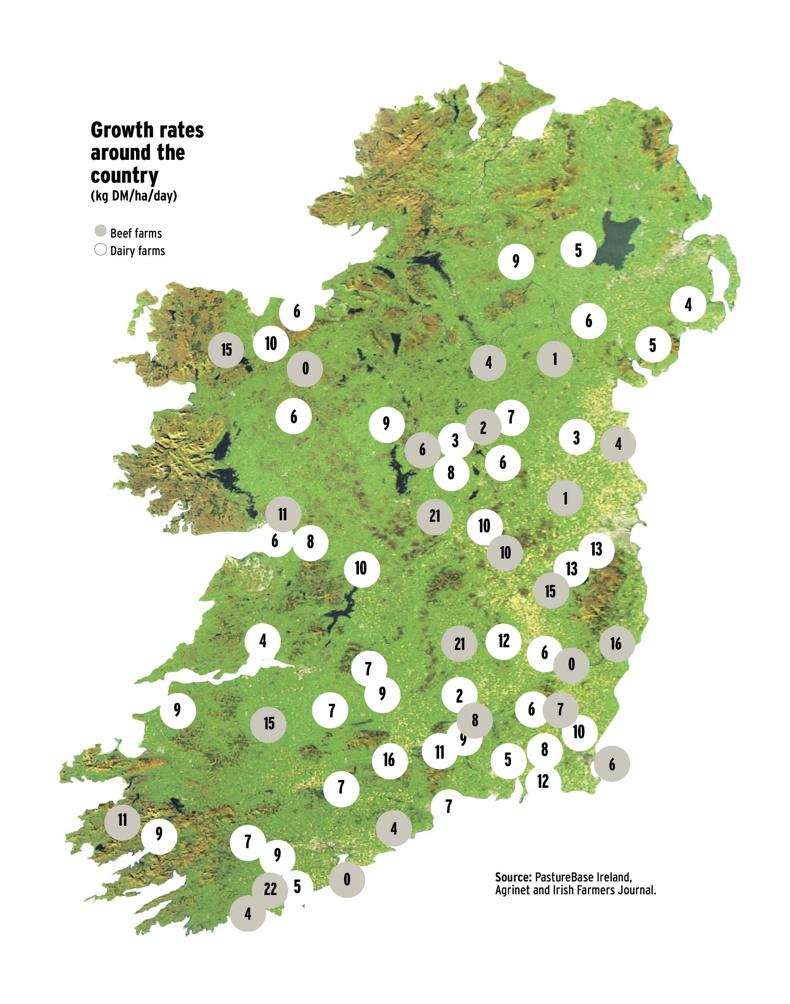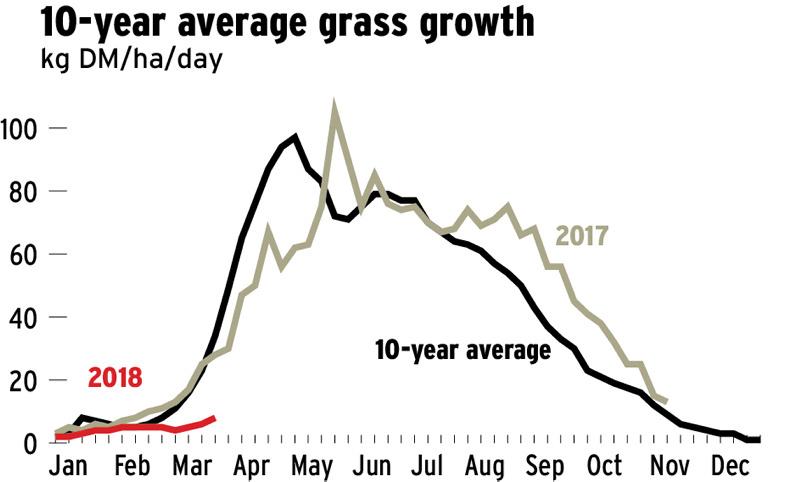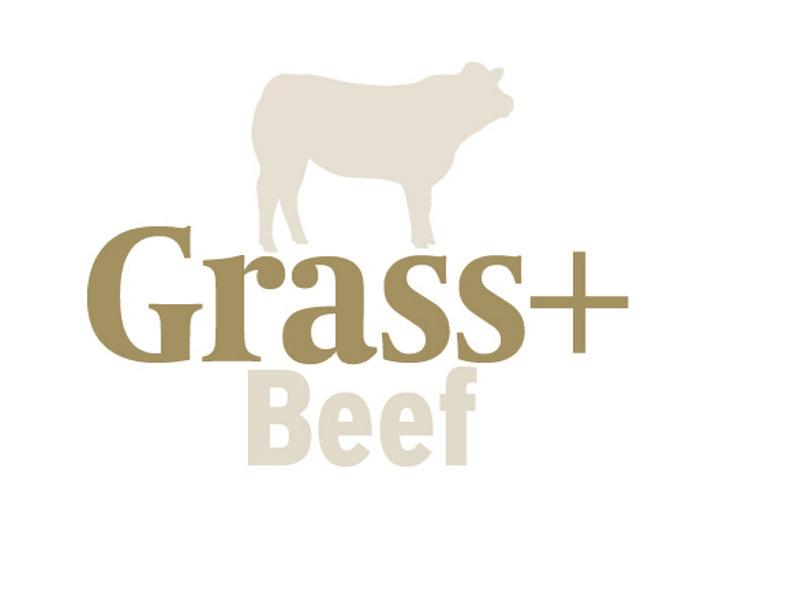Average growth for this week in the years 2015 to 2017 was 26kg DM/ha/day, according to figures from the Teagasc Pasturebase system. However, at 9kg DM/ha/day, we are still well back on this and grass supply is becoming a real issue now.
Most farmers are reporting that they can finally get animals out on fields but there is no grass. Indeed, grass has been lost in places where paddocks have been closed up since early October and got no nutrients since.
There are also farmers on the other end of the spectrum who were forced to house animals early in the inclement weather last October and as a result have lots of grass on the farm. While they have a feed supply that will take pressure off potentially low fodder stocks, they still have a slight problem in that they could be looking into a grass tsunami if and when growth spikes.
The advice for both is the same. Pick a date between 20 and 25 April and aim to have the whole farm grazed between now and then. If you have 25ha to graze, that’s roughly 1ha per day. Twenty cows and calves will eat a hectare with 10cm of grass cover in 3.5 days. On an 8cm cover, they’ll last 2.5 days. Forty forward stores will eat a 1ha paddock of 10cm grass in three days.
More simply, work out your average farm cover in kg DM/ha – average cm per paddock, subtract four, multiply by 250. Divide this figure by your daily demand per ha – stocking rate in LU/ha multiplied by 18. You will be left with a days-ahead figure. This figure is basically the days of feeding left on the farm if growth remained at zero – which at present is a reality for some. We want a figure of around 25 days ahead at the moment.
For farmers with less than 21, we need to stretch our grass out. Do so by offering some silage or hay under the wire to animals, or concentrate feeds if these are scarce.
Farms with more than 28 days of grass on the farm at this point should be looking to get more cattle to grass, provided the weather and ground permits. If it is too wet, close extra silage ground.


Co Limerick
System suckler to weanling
Soil type highly variable
Farm cover (kg DM/ha) 554
Demand (kg DM/ha/day) 3
Growth (kg DM/ha/day) 31
I now have 30 cows and calves at grass on dry land along with 29 yearling Hex bullocks. The yearlings are grazing my heavier ground and so far are managing OK despite ground being sticky.
I spread two bags per acre of 18-6-12 on 10 acres of heavy ground last weekend. Ground was wet in patches but I felt it was better to get it out before the week’s rain came in case I couldn’t travel.
As my land quality is very variable, I am on the second rotation at home on my dry land but am only starting on my heavy land.
I plan to fertilise for silage by the weekend if the weather’s OK. I will apply 100 units per acre of nitrogen in the form of urea and will cut around 20 May, if weather allows. I spread 2,500 gallons of slurry on this land earlier in the spring to provide P and K.
Silage is running low with me but I’m hopeful the weather will turn soon to allow the last of my stock out to grass.

Co Roscommon
System suckler to weanling/beef
Soil type free-draining loam
Farm cover (kg DM/ha) 575
Demand (kg DM/ha/day) 7
Growth (kg DM/ha/day) 6
Cows and calves were out earlier in the week but with the rain ground conditions have deteriorated again. I housed the cows but calves are going out via a creep gate. Although it is cold, they seem to be content and from a health point of view it’s working well with no scours to report.
I’ve 80% of the herd calved in seven weeks. Silage is scarce with 10 days left but I do have healthy covers of grass. I’ve 36 heifers clipping off silage ground and slurry should be out by this weekend.
Lime was spread on an outfarm earlier in the month and has since got 1.5 bags of 18-6-12 to kickstart growth. Finishing bulls are almost on ad-lib meal. I’m giving them straw now to save the last of my silage.
We’re probably a month behind where we were last year in terms of grass growth. I’ve also vaccinated cows against lepto for the first time and they will get a booster shot again in four weeks’ time.

Derrypatrick Herd
System suckler to beef
Soil type mixed
Farm cover (kg DM/ha) 817
Demand (kg DM/ha/day) 0
Growth (kg DM/ha/day) 1
Due to poor ground and weather conditions, all cattle remain housed. There is a good supply of silage and therefore fodder is not an issue. However, space is limiting for cows and calves and as a result, we have improvised and have constructed a temporary creep area adjoining a number of slatted pens.
Ground conditions have improved over the last seven days. However, rainfall on Monday night has delayed turnout once again. Grazing silage ground will be a priority once cattle are turned out, with the aim to graze as much as possible by the end of the first week of April. Ground and weather conditions will be monitored closely over the coming days and cattle will be turned out when suitable.
This week, a number of calves were dull and had cases of scour. When checked, they had high temperatures (>39.5°C) and were subsequently treated for pneumonia. In total, 70 cows have calved with 71 live calves at foot.

Co Louth
System suckler to bull beef
Soil type free-draining
Farm cover (kg DM/ha) 607
Demand (kg DM/ha/day) 6
Growth (kg DM/ha/day) 4
There is a nice cover of grass presently on farm but the big challenge is getting out to it. I turned out a group of yearling heifers last week and yesterday I got out a group of autumn-calving cows. The main priority now is to get silage ground grazed off so I can fertilise it and get it closed.
I got out with slurry on low covers back in early February and the remainder of the land got approximately three-quarters of a bag of urea/acre. I hope to go with 30 units of urea on the ground that got slurry early next week to push on the growth as my grass demand will jump rapidly in the next few weeks.
I am down to my last four cows to calve and hopefully they will be soon out of the way.
Thankfully I have plenty of silage left should this bad weather stay. Last year’s spring-born bulls are on high-cereal ration ad-lib and they look to be doing very well and should be on target for finishing under 16 months.


Read more
Grass plus: No big change in growth rates
Average growth for this week in the years 2015 to 2017 was 26kg DM/ha/day, according to figures from the Teagasc Pasturebase system. However, at 9kg DM/ha/day, we are still well back on this and grass supply is becoming a real issue now.
Most farmers are reporting that they can finally get animals out on fields but there is no grass. Indeed, grass has been lost in places where paddocks have been closed up since early October and got no nutrients since.
There are also farmers on the other end of the spectrum who were forced to house animals early in the inclement weather last October and as a result have lots of grass on the farm. While they have a feed supply that will take pressure off potentially low fodder stocks, they still have a slight problem in that they could be looking into a grass tsunami if and when growth spikes.
The advice for both is the same. Pick a date between 20 and 25 April and aim to have the whole farm grazed between now and then. If you have 25ha to graze, that’s roughly 1ha per day. Twenty cows and calves will eat a hectare with 10cm of grass cover in 3.5 days. On an 8cm cover, they’ll last 2.5 days. Forty forward stores will eat a 1ha paddock of 10cm grass in three days.
More simply, work out your average farm cover in kg DM/ha – average cm per paddock, subtract four, multiply by 250. Divide this figure by your daily demand per ha – stocking rate in LU/ha multiplied by 18. You will be left with a days-ahead figure. This figure is basically the days of feeding left on the farm if growth remained at zero – which at present is a reality for some. We want a figure of around 25 days ahead at the moment.
For farmers with less than 21, we need to stretch our grass out. Do so by offering some silage or hay under the wire to animals, or concentrate feeds if these are scarce.
Farms with more than 28 days of grass on the farm at this point should be looking to get more cattle to grass, provided the weather and ground permits. If it is too wet, close extra silage ground.


Co Limerick
System suckler to weanling
Soil type highly variable
Farm cover (kg DM/ha) 554
Demand (kg DM/ha/day) 3
Growth (kg DM/ha/day) 31
I now have 30 cows and calves at grass on dry land along with 29 yearling Hex bullocks. The yearlings are grazing my heavier ground and so far are managing OK despite ground being sticky.
I spread two bags per acre of 18-6-12 on 10 acres of heavy ground last weekend. Ground was wet in patches but I felt it was better to get it out before the week’s rain came in case I couldn’t travel.
As my land quality is very variable, I am on the second rotation at home on my dry land but am only starting on my heavy land.
I plan to fertilise for silage by the weekend if the weather’s OK. I will apply 100 units per acre of nitrogen in the form of urea and will cut around 20 May, if weather allows. I spread 2,500 gallons of slurry on this land earlier in the spring to provide P and K.
Silage is running low with me but I’m hopeful the weather will turn soon to allow the last of my stock out to grass.

Co Roscommon
System suckler to weanling/beef
Soil type free-draining loam
Farm cover (kg DM/ha) 575
Demand (kg DM/ha/day) 7
Growth (kg DM/ha/day) 6
Cows and calves were out earlier in the week but with the rain ground conditions have deteriorated again. I housed the cows but calves are going out via a creep gate. Although it is cold, they seem to be content and from a health point of view it’s working well with no scours to report.
I’ve 80% of the herd calved in seven weeks. Silage is scarce with 10 days left but I do have healthy covers of grass. I’ve 36 heifers clipping off silage ground and slurry should be out by this weekend.
Lime was spread on an outfarm earlier in the month and has since got 1.5 bags of 18-6-12 to kickstart growth. Finishing bulls are almost on ad-lib meal. I’m giving them straw now to save the last of my silage.
We’re probably a month behind where we were last year in terms of grass growth. I’ve also vaccinated cows against lepto for the first time and they will get a booster shot again in four weeks’ time.

Derrypatrick Herd
System suckler to beef
Soil type mixed
Farm cover (kg DM/ha) 817
Demand (kg DM/ha/day) 0
Growth (kg DM/ha/day) 1
Due to poor ground and weather conditions, all cattle remain housed. There is a good supply of silage and therefore fodder is not an issue. However, space is limiting for cows and calves and as a result, we have improvised and have constructed a temporary creep area adjoining a number of slatted pens.
Ground conditions have improved over the last seven days. However, rainfall on Monday night has delayed turnout once again. Grazing silage ground will be a priority once cattle are turned out, with the aim to graze as much as possible by the end of the first week of April. Ground and weather conditions will be monitored closely over the coming days and cattle will be turned out when suitable.
This week, a number of calves were dull and had cases of scour. When checked, they had high temperatures (>39.5°C) and were subsequently treated for pneumonia. In total, 70 cows have calved with 71 live calves at foot.

Co Louth
System suckler to bull beef
Soil type free-draining
Farm cover (kg DM/ha) 607
Demand (kg DM/ha/day) 6
Growth (kg DM/ha/day) 4
There is a nice cover of grass presently on farm but the big challenge is getting out to it. I turned out a group of yearling heifers last week and yesterday I got out a group of autumn-calving cows. The main priority now is to get silage ground grazed off so I can fertilise it and get it closed.
I got out with slurry on low covers back in early February and the remainder of the land got approximately three-quarters of a bag of urea/acre. I hope to go with 30 units of urea on the ground that got slurry early next week to push on the growth as my grass demand will jump rapidly in the next few weeks.
I am down to my last four cows to calve and hopefully they will be soon out of the way.
Thankfully I have plenty of silage left should this bad weather stay. Last year’s spring-born bulls are on high-cereal ration ad-lib and they look to be doing very well and should be on target for finishing under 16 months.


Read more
Grass plus: No big change in growth rates













 This is a subscriber-only article
This is a subscriber-only article
















SHARING OPTIONS: